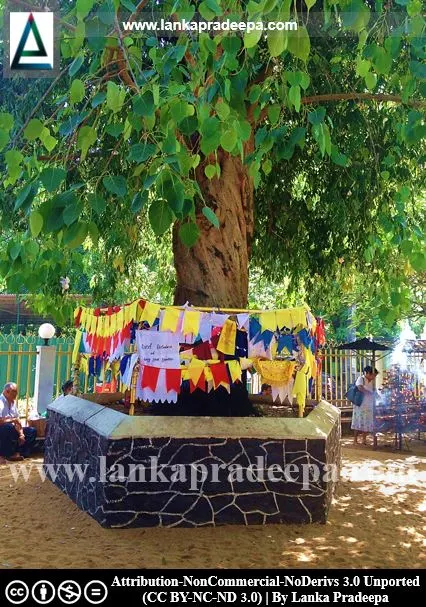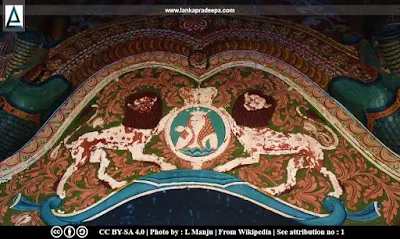
Kotte Raja Maha Viharaya (Sinhala: කෝට්ටේ රජ මහා විහාරය) is a Buddhist temple situated in Pitakotte in Colombo District, Sri Lanka.
History
Kotte Viharaya was the main religious centre of the Kotte Kingdom during the 15 century and it is described in detail in several Sandesha Kavya (poetic literature) of the era. The temple was majorly developed under the patronage of King Parakramabahu VI [(1412-1467 A.D.) Manathunga, 2016; Rajapakshe et al., 2018]. This temple is mentioned in the 15th-century Sinhalese text Nampotha as "Jayawardhana Kottayehi Oth Pilima Geya" & "Shanmukha Devalaya". The Oth Pilima Geya (the house of the reclining statue) is believed to be the image house (with the reclining Buddha statue) of the old Kotte temple built by King Parakramabahu VI while the shrine in front of it, is believed to be the Shanmukha Devalaya.
At the time, the temple is said to be completed in all aspects including a three-storeyed Temple of the Tooth (for the Tooth Relic of the Buddha), a Stupa, a Bodhi tree, an image house, and a Pohoya Geya (Chapter House). It was located near the royal palace of Kotte and therefore, received much patronage from the kings of the Kotte Kingdom. However, with the downfall of the kingdom, the temple confronted invasions by the Portuguese as well as the Dutch (Rajapakshe et al., 2018; Sarma, 2007). During the Dutch period, the temple was completely destroyed.
The destroyed temple was re-established by Pilane Buddha Rakkhitha Thera in 1813, by utilizing the ruins and remains of the old temple (Rajapakshe et al., 2018; Wijewardana et al., 2011). New constructions such as an image house and a Vahalkada/Vahal Doratuwa (the entrance to the temple premises) were added to the temple subsequently by Buddha Rakkhitha Thera.
Folklore
Presently, a Na-tree (ironwood) located a few meters outside the temple premises, is worshipped as a sacred tree by the local people. They connect the history of this tree with Prince Sapumal (the adopted son of King Parakramabahu VI) who attacked Jaffna (Yapa Patuna) and brought it under the control of the Kotte Kingdom. According to them, Prince Sapumal had made a vow to this Na-tree before his departure to capture the Jaffna peninsula.
Image house
The image house which is rectangular in shape is about 40 ft. long, 30 ft. wide, and 40 ft. high (Rajapakshe et al., 2018). The open verandah facing the north provides access to the image house and its roof is supported by eight pairs of cylindrical-shaped pillars.
The image house consists of two sections; the outer hall and the middle Mandapaya (a pavilion). The outer hall runs around the middle Mandapaya and can be accessed through two separate entrances. The middle Mandapaya also contains two compartments: the outer and inner sections. The front and sidewalls of the outer section have been adorned with Kandyan Era paintings (Southern School art style) and sculptures depicting floral decorations, divinities, and Jathaka stories such as Thelapatta, Manichora, Chulla Paduma, and Kattahari (Rajapakshe et al., 2018). The inner section which can be accessed through two entrances houses four Buddha statues; a large reclining statue, and three standing statues (Rajapakshe et al., 2018). A portrait of Queen Victoria and a crest containing the name "Jayawardana Kotte Jayawardhana Maha Vihara" in English are found drawn over the right and left entrance doors of the inner section (Rajapakshe et al., 2018).
Queen Victoria at Kotte Raja Maha Viharaya
A portrait of Queen Victoria who received the coronation
as the queen of all colonial countries has been painted
over the inner entrance (the right door) of the image house
of Kotte Raja Maha Viharaya. A similar portrait can be
seen at Dehiwala Karagampitiya Viharaya.
Reference: Chutiwongs et al., 1990. p.34.
Besides the old image house, several other constructions such as the Vahal Doratuwa, the Kataragama Devalaya, and the Bamunu Geya are considered old monuments with archaeological interests (Rajapakshe et al., 2018).
A protected site
All artefacts and the ancient Wahalkada (gateway) located in the territory of the Kotte Raja Maha Vihara in the Grama Niladari Division of Pitakotte (GND No. 522) in Sri Jayawardenapura Kotte Divisional Secretary’s Division are archaeological protected monuments, declared by a government Gazette notification published on 20 June 2014.




.
See also
Travel tips
Things to do at Kotte Raja Maha Viharaya;Buddhist temples are crowded on Poya days (full moon) and various religious ceremonies are taken place on the day. Tourists can pray, participate in religious ceremonies, offer flowers and light incense and oil lamps for Buddha, meditate, listen to Dhamma preaching and interact in discussions led by monks and make offerings to them expecting merits.
Some etiquette to be followed at Buddhist temples;
Short outfits are not considered suitable for visiting religious places. A long skirt with a cover-up for shoulders and arms, light pants or sarong and sandals are okay when visiting the temple. Do not wear garments containing religious symbols. Remove shoes and hats when entering the premises. Do not pose beside or in front of Buddha statues (with your back to it) as it is considered disrespectful. Taking photographs is not prohibited in many Buddhist temples but ask permission before photographing people.
Attribution
1) Kotte Raja Maha Vihara 1 by L Manju is licensed under CC BY SA 4.0
References
1) Chutiwongs, N.; Prematilaka, L.; Silva, R., 1990. Sri Lanka Bithu Sithuwam: Karagampitiya (Paintings of Sri Lanka: Karagampitiya). Sri Lanka Archaeological Authority: Centenary publication. Central Cultural Fund. p.34.
2) Manathunga, S. B., 2016. Pauranika Sthana Saha Smaraka: Kolamba Distrikkaya (In Sinhala). Department of Archaeology (Sri Lanka). ISBN: 955-9159-39-9. p.85.
3) Rajapakshe, S.; Bandara, T. M. C.; Vanninayake, R. M. B. T. A. B. (Editors), 2018. Puravidya Sthana Namavaliya: Kolamba Distrikkaya (In Sinhala). Vol. I. Department of Archaeology (Sri Lanka). ISBN: 978-955-7457-19-2. pp.7-5.
4) Sarma, B.S., 2007. History of Munneswaram Temple. Sri Sankar Publications. p.21.
3) Rajapakshe, S.; Bandara, T. M. C.; Vanninayake, R. M. B. T. A. B. (Editors), 2018. Puravidya Sthana Namavaliya: Kolamba Distrikkaya (In Sinhala). Vol. I. Department of Archaeology (Sri Lanka). ISBN: 978-955-7457-19-2. pp.7-5.
4) Sarma, B.S., 2007. History of Munneswaram Temple. Sri Sankar Publications. p.21.
5) The Gazette of the Democratic Socialist Republic of Sri Lanka. No: 1868. 20 June 2014. p.503.
6) Wijewardana, A., Thilakawardana, A. E. L., Priyangani, S., 2011. Aithihasika Kotte (In Sinhala). Department of Archaeology (Sri Lanka). ISBN: 978-955-9159-69-8. pp.19-20.
6) Wijewardana, A., Thilakawardana, A. E. L., Priyangani, S., 2011. Aithihasika Kotte (In Sinhala). Department of Archaeology (Sri Lanka). ISBN: 978-955-9159-69-8. pp.19-20.
Location Map
This page was last updated on 21 April 2023


